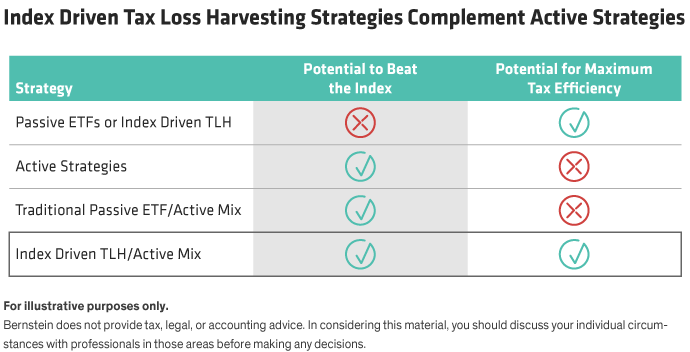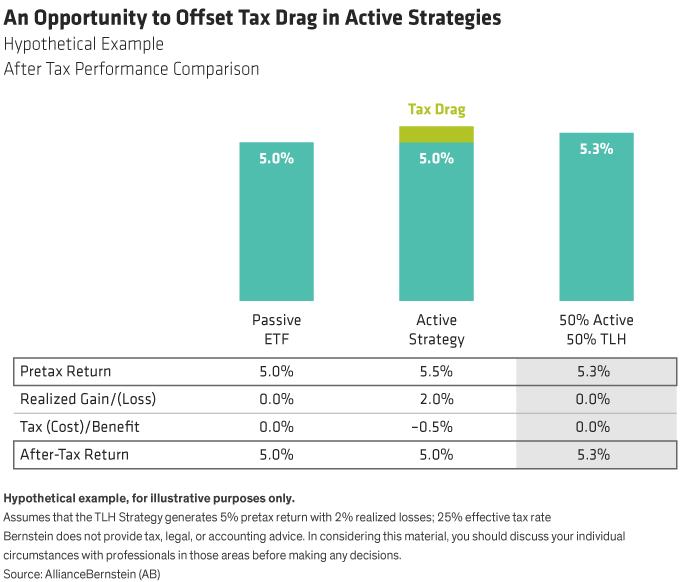Enduring slogans like Reese’s peanut butter cups, “Two great tastes that taste great together” stand the test of time for a reason. They encapsulate the best of both worlds while offering a new twist. Now investors can strive for the same ideal by combining an active equity portfolio with an index-driven tax-loss-harvesting strategy. The mix aims to beat an index ETF after taxes—by potentially outperforming on a pretax basis while delivering greater tax efficiency.
An Ideal Combo
To understand how this raises the bar, let’s explore what each side brings to the table, starting with how investors measure success. Notably, while pretax returns might confer bragging rights, it’s their after-tax counterparts that matter most for taxable investors because they drive your ability to meet your financial goals. In other words, pretax returns may appear on your statement, but after-tax returns are what you take to the bank.
For instance, active equity strategies may outperform before taxes are factored in, but their turnover can create a big tax bill for their investors. Compare that to index ETFs, which only match the benchmark pretax (no bragging rights there!) but are extremely tax efficient.
But what if—like that timeless confectionary blend—you had the chance to beat the index without sacrificing tax efficiency? This combination significantly improves an investor’s likelihood of outperforming an index ETF after taxes, which should be every taxable investor’s ultimate goal.
Setting a Bogey for After-Tax Returns
Why use index ETFs as your yard stick for measuring after-tax returns? Because ETFs are extremely tax efficient, and almost never distribute capital gains to their investors. Instead, they avoid capital gains by passing out highly appreciated portfolio holdings to Authorized Participants (typically large investment banks). That means most investors in an index ETF will only pay capital gains taxes on their investment if and when they sell it, making index ETFs a perfect benchmark for taxable investors measuring after-tax returns.
In contrast, a successful active equity manager is likely to realize gains over time, creating a tax expense for taxable clients. This expense, or tax drag, frequently leads active equity managers to underperform an index ETF once taxes are accounted for—even when they outperform on a pretax basis! To meet the higher standard of outperforming on an after-tax basis, most active managers must deliver sufficient excess returns before taxes to offset their higher tax expense.
A Compelling Complement
What taxable investors need is a way to reduce the capital gains tax expense of active equity managers without sacrificing their ability to outperform (on a pretax basis).
That’s where Index Driven Tax Loss Harvesting Strategies come into play. These are designed to generate similar pretax returns as equity index ETFs, while harvesting losses in their portfolios to capture tax benefits that can offset tax expenses. In effect, investors target a “win-win” by marrying an active manager’s potential for excess return with the tax efficiency of an index-driven TLH strategy.
Note that these tax benefits are only of value if they can be used as an offset. That’s why we recommend combining them with active equity strategies elsewhere in your portfolio. That way, the tax benefits arising from tax-loss harvesting can mitigate the tax expense created by turnover in the actively managed portion of your account.

Better Off in the End
Combining the two strategies is likely to dilute pretax outperformance but enhance after-tax returns—leaving the investor better off than had she invested in active strategies alone. Remember, pretax returns are great for self-esteem, but after-tax returns translate to actual dollars and cents by determining what you keep or spend in everyday life.
To demonstrate, let’s compare hypothetical before and after-tax returns for an index ETF, an actively managed strategy, and a 50/50 combination of the latter plus an index-driven tax-loss-harvesting strategy (Display). The active strategy generates the highest pretax return, but the tax expense associated with doing so drags the after-tax return down to the level of the index ETF.
What happens when we combine the actively managed strategy with an index-driven tax-loss-harvesting strategy? It dilutes the pretax outperformance of the actively managed strategy—but by eliminating the tax expense, increases the after-tax return of the active strategy by itself.

Best of Both Worlds
People accidentally combining their chocolate and peanut butter snacks made for a candy revolution back in the day. Fortunately, investors don’t need to stumble upon such a combo. They can deliberately avoid settling for an either/or approach to active and passive strategies. The combination of an Index Driven Tax Loss Harvesting Strategy and an actively managed equity portfolio provides the opportunity to beat an index ETF after taxes—without sacrificing tax efficiency.
- Paul Roberston
- Senior National Director, Tax & Transition Strategies—Investment Strategies Group
- John McLaughlin
- Portfolio Manager—Tax-Managed Strategies and Transitions

